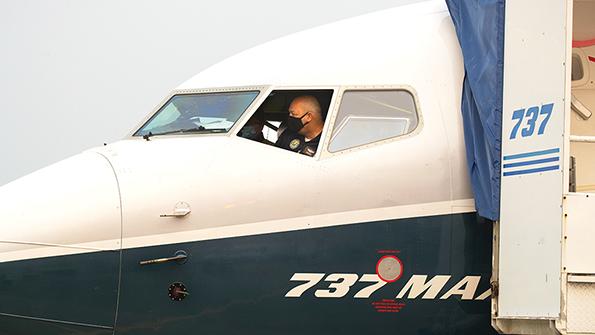
Ask the Editors: The Aviation Week Network invites our readers to submit questions to our editors and analysts. We’ll answer them, and if we can’t we’ll reach out to our wide network of experts for advice.
How much time will the new Boeing 737 MAX pilot training take?
Aviation Week Air Transport & Safety Editor Sean Broderick responds:
The short answer: About 5 hr., including 2 hr. in the simulator.
The details: New minimum training requirements for 737 MAX pilots have not been finalized. But it is a safe bet that what FAA Administrator Steve Dickson went through to prepare for his Sept. 30 demo flight—and what is outlined in a draft Flight Standardization Board (FSB) report out for public comment through Nov. 2—is pretty close to what will be approved.
The training will be split into two parts. The “ground” training—think computer-based distance learning that can be done on a tablet—will take 90-120 min. It will be broken into modules that cover key issues, including the MAX’s Maneuvering Characteristics Augmentation System (MCAS) flight-control law, other flight-control computer (FCC) updates and several non-normal procedures. There is a heavy emphasis on reviewing seven non-normal checklists that have changed.
Next up is mandatory simulator sessions. Actual device time is expected to take about 2 hr. But an added briefing and a 3-hr. block for the simulator portion are a safe bet.
The draft FSB report spells out the minimum that must be done in the simulator. Airlines can add more scenarios, of course, but these—straight from the draft—are the five scenarios the FAA is proposing:
-
Demonstration of MCAS activation for each pilot;
-
A runaway stabilizer condition that requires the pilots to use manual stabilizer trim;
-
Use of manual stabilizer trim during approach, go-around and level-off phases of flight;
-
A cross-FCC trim monitor activation demonstration accomplished by either pilot acting as pilot flying (PF);
-
Erroneous high-angle-of-attack alert on takeoff that leads to an unreliable airspeed condition accomplished by either pilot acting as PF.
Note that items 2 and 3 can be done on either a 737NG or a 737 MAX simulator, as the scenarios apply to each type and are not affected by Boeing’s changes to the MAX.
The full draft FSB report, plus instructions on how to comment, is available until Nov. 2: faa.gov/aircraft/draft_docs/fsb/
Simulator availability will be the pacesetter for airlines. Southwest Airlines expects to take at least two months to train its 9,800 pilots. American Airlines—who does not want to have every one of its pilots qualified on the MAX, unlike all-737 operator Southwest—scheduled about three months to train 4,200 pilots.
Pilots also need to work the sessions into their schedules, of course, which should be an easier task now that COVID-19 has lightened schedules considerably.

Comments
1. High speed issues per Ethiopian 302 MAX crash.
2. Trim Motor Seized Up: As I understand it, the system has a clutch between the motor and the drive. Ergo, if the motor seizes up, in order to Trim, you need to break the clutch free of the motor to turn the gears and get Trim Movement.
I have only seen this mentioned a couple of times and not addressed at all in any documents I have seen.